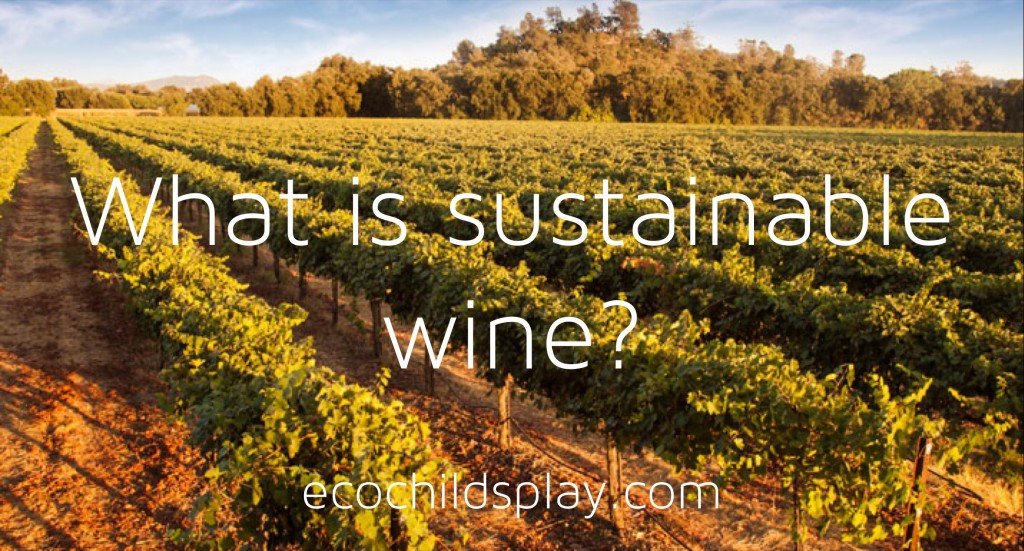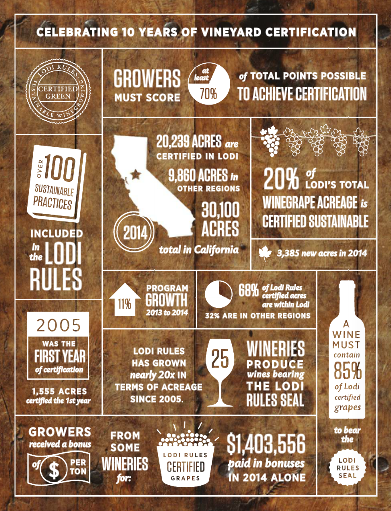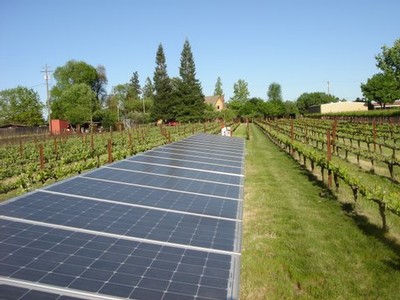
The wine industry has lots of dirty secrets. From consuming water in times of drought to using roundup to control weeds, wine grape growing can have its toll on the environment and human health. There is a solution: Sustainable wine!
I love wine. It brings me pleasure to have a glass in the evenings after dinner, but this joy would be tainted by eco-guilt if I did not commit my wine drinking to only sustainable and/or organic vineyards.
How is sustainable wine different?
The Dr. Vinny of Wine Spectator explains what the term sustainability means in the wine industry:
Sustainability refers to a range of practices that are not only ecologically sound, but also economically viable and socially responsible. (Sustainable farmers may farm largely organically or biodynamically but have flexibility to choose what works best for their individual property; they may also focus on energy and water conservation, use of renewable resources and other issues.) Some third-party agencies offer sustainability certifications, and many regional industry associations are working on developing clearer standards.((http://www.winespectator.com/drvinny/show/id/41226))
 We were sent two bottles fo wine from Lodi, California that Certified Green by Lodi Rules.((http://cld.bz/xAHQKTo#20)) I wish I could describe the lovely flavors of these vintages, but I am not a wine connoisseur of that sophistication.
We were sent two bottles fo wine from Lodi, California that Certified Green by Lodi Rules.((http://cld.bz/xAHQKTo#20)) I wish I could describe the lovely flavors of these vintages, but I am not a wine connoisseur of that sophistication.
Lodi Rules has been certifying wine as green for ten years.
 Wine Business explains the program:
Wine Business explains the program:
It promotes practices that enhance biodiversity, soil and water health, community and employee wellbeing, ensuring that farming needs are met today without compromising the needs of future generations. The goal of the program is to support grower adoption of sustainable practices and to communicate this commitment to wineries and the general public. Lodi Rules™ has been and continues to be used as a model for other sustainable winegrowing certification programs internationally…
Furthermore, the report serves to quantify how winegrowers participating in the Lodi Rules™ program have been successful at adopting its flagship sustainable practices. For example, in the ecosystem management chapter, 92% of growers have installed nest boxes for raptors and birds to increase habitat biodiversity. In the human resources chapter, 62% have implemented a safety rewards program to incentivize their workforce to take extra precaution against on-the-job injury. In the soil management chapter, 93% of growers have used cover crops to prevent soil erosion. Overall, adoption rates averaged across each of the six chapters ranged from an impressive 77% to 90%.((http://www.winebusiness.com/news/?go=getArticle&dataid=156081))
From St. Amant Winery we received a bottle of Barbera. This red wine is made from a 35-year-old vineyard. Older vineyards have been faring well in the California drought and are typically dry farmed. The New York Times explains:
Most of those old vineyards have been dry-farmed for years. At Smith-Madrone, Stuart Smith has become convinced that dry-farming is the way to go, not just because he thinks it results in better wine but because water in California has always been a moral issue. He said he’s seen far too many vineyards irrigated to achieve a garden-like beauty, to the detriment of both wine and water supplies.
“From a wine-quality and a responsible-citizen position, we should all use less water,” he said. “Wine growers can make better wines and be better ecological neighbors if they thought about vineyards differently.”((http://www.nytimes.com/2015/08/26/dining/wine-california-drought.html?_r=0))
 From Bokisch Vineyards we received a bottle fo Albarino. This vineyard is also green certified and specializes in Spanish wines.
From Bokisch Vineyards we received a bottle fo Albarino. This vineyard is also green certified and specializes in Spanish wines.
Bokisch is serious about sustainability:
Beyond Organics …
The holistic approach of sustainable winegrowing addresses many integral aspects of vineyard management beyond simply not using certain pesticides in vineyards. Eight examples of how Bokisch Vineyards employs Sustainable Winegrowing Practices are listed below:
- Alternative Fuel Use : By 2009 we will be converted to biodiesel for our tractors & equipment.
- Alternative Energy Use : In 2004 we installed a 22.5 kilowatt solar energy system for two irrigation pumps covering 70 acres of vineyard, our main shop and two homes.
- Human Resources/Labor Relations : We maximize our ability to provide year round employment for our vineyard employees to better serve our community.
- Integrated Pest Management : We limit our pesticide use to a bare minimum in all our vineyards and have farmed 35 acres of vineyard organically for eight years. Creating and maintaining owl habitat helps us control our gopher and meadow vole populations naturally. See pictures and read about our Owl Condos.
- Air Quality Control : We cover crop our vineyard rows and avenues to minimize dust.
- Soil & Water Management : We minimize irrigation and erosion in order to maximize nutrition in our soils which results in higher, more concentrated fruit quality.
- Land Stewardship : We combine our management of agriculture with the ecosystem by providing riparian zones, oak woodlands and by maintaining vernal pools.
- Central Valley Farmland Trust(CVFT): We are founding members of this Non-Profit Farmland Trust which has purchased conservation easements for the preservation of agriculture.((http://www.bokischvineyards.com/About-Us/Sustainable))

Although there are some general commonalities in sustainability across industries, true sustainability varies by region and local micro climate. What one vineyard needs to do to be sustainable may differ from another vineyard in practicality and implementation.
What I love about sustainable wine compared to simply organic wine, much of which has gotten a bad rap for quality, is sustainability takes into account more than just pesticide, herbicide, and fertilizer use. It takes into consideration the human resources and community. This is where many sustainable enterprises vary.
According to the St. Amant Winery, the Lodi Rules program
…takes a comprehensive approach to farming that goes beyond just pest management to promote practices that enhance biodiversity, water and air quality, soil health, economic viability, and employee and community well-being. The program has 101 farming practices that have been peer-reviewed by scientists, academics, and environmental organizations before being accredited by Protected Harvest. ((http://www.stamantwine.com/Vineyards/Sustainable-Winegrowing))
This comprehensive approach is what makes wine sustainable with no loss to quality. Sustainable wine allows for guilt-free enjoyment! It is socially and enviromentally responsible.
What a nice article and thank you for supporting sustainability. Consumers looking for sustainable wines can also look for the SIP Certified seal. This third-party verified certification ensures that vineyards are addressing sustainable practices from habitat conservation to water quality, energy efficiency to air quality, business stability to taking care of their workers. SIP Certified – An easy way for you to know you’re buying sustainable wines that give back to the land and community. SIPcertified.org